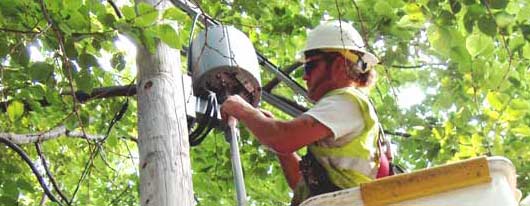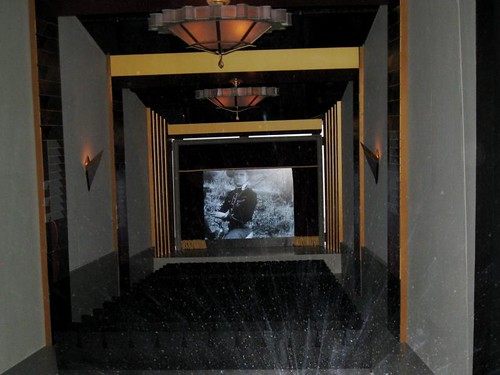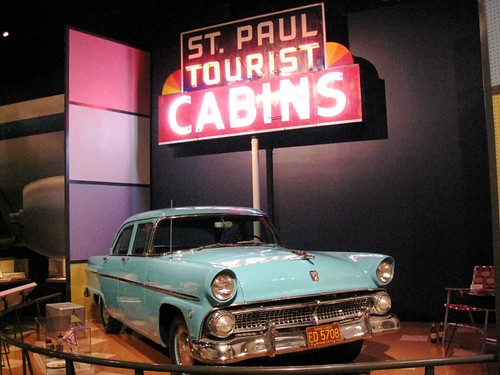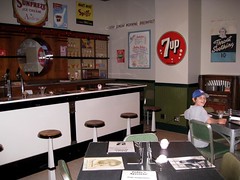
Worker adjusting the wireless access point outside my window.
Featured Tag: Wireless
Main Tags
art
blogging
learning
mac
movies
other
politics
science
tech
wireless
Saturday, May 30, 2009
Tumb, tumbling away
pfhyper started a tumblr blog. I think I'll use it to store links where I want to say more than 140 characters (the twitter limit). Plus Twitter doesn't archive well yet. We don't really know if our early tweets are in a database somewhere or not.
Minneapolis Unwired: Dead zones & IOUs (plus a Wi-Fi in the parks update)
Steve Alexander has a report on the Minneapolis Wi-Fi deployment at the Star Tribune. Judging from the dates on the comments, I think it's from May 26 but there's no dateline on the story.
The gist is that it's not done which is also the ongoing mantra. "It's always something" as Gilda would say. Prospect Park is still a "challenge" area and there are others around the metro--a total of three square miles still unwired. The park issue I reported on before seems to be resolved and a contract is in place with a bit of money changing hands from US Internet to the Park Board. (Read details over at the eDemocracy Forum).
The City of Minneapolis is using only $50,000 worth of services but paying $1.25 million per year. The article says the money carries over (an IOU so to speak) so supposedly we will get full value eventually. Some reasons we aren't getting full value now are because the network needs to actually be complete before Police and Fire will mess with it and because some City departments are slow in adopting the service.
Alexander talks about using the network to track video from a police car going 80mph. I would love to know how that is possible. I don't think the current network, in areas where it is fully implemented, allows you to smoothly travel from node to node in a car without losing the connection some of the time. So do we have a "special" high-speed backend network for police and fire? I know there is a "public safety" channel or something but if it's still in the Wi-Fi range, it would be subject to all kinds of interference.
US Internet meanwhile says they now have 14,000 subscribers. Those numbers should eventually translate to cash infusions in the City's Digital Inclusion Fund with a minimum of 5% of net pretax income. The fund has $100,000 left of the initial $500,000 from US Internet. The fund and the money are part of the Community Benefits Agreement in the contract. I'm on the Digital Inclusion Fund Committee and so far we have not heard when we will receive more money and we have postponed this years grant-making cycle.
We are still the muni-wi-fi poster child of the world. It's working here because the City of Minneapolis signed on as anchor tenant and is paying a hefty fee to support a network. However, unless the City starts to get its money's worth of services soon, we may have rethink this poster child status.
The gist is that it's not done which is also the ongoing mantra. "It's always something" as Gilda would say. Prospect Park is still a "challenge" area and there are others around the metro--a total of three square miles still unwired. The park issue I reported on before seems to be resolved and a contract is in place with a bit of money changing hands from US Internet to the Park Board. (Read details over at the eDemocracy Forum).
The City of Minneapolis is using only $50,000 worth of services but paying $1.25 million per year. The article says the money carries over (an IOU so to speak) so supposedly we will get full value eventually. Some reasons we aren't getting full value now are because the network needs to actually be complete before Police and Fire will mess with it and because some City departments are slow in adopting the service.
Alexander talks about using the network to track video from a police car going 80mph. I would love to know how that is possible. I don't think the current network, in areas where it is fully implemented, allows you to smoothly travel from node to node in a car without losing the connection some of the time. So do we have a "special" high-speed backend network for police and fire? I know there is a "public safety" channel or something but if it's still in the Wi-Fi range, it would be subject to all kinds of interference.
US Internet meanwhile says they now have 14,000 subscribers. Those numbers should eventually translate to cash infusions in the City's Digital Inclusion Fund with a minimum of 5% of net pretax income. The fund has $100,000 left of the initial $500,000 from US Internet. The fund and the money are part of the Community Benefits Agreement in the contract. I'm on the Digital Inclusion Fund Committee and so far we have not heard when we will receive more money and we have postponed this years grant-making cycle.
We are still the muni-wi-fi poster child of the world. It's working here because the City of Minneapolis signed on as anchor tenant and is paying a hefty fee to support a network. However, unless the City starts to get its money's worth of services soon, we may have rethink this poster child status.
Labels: broadband, minneapolis, municipal, politics, USIW, Wi-Fi, wireless
Friday, May 22, 2009
"Minnesota's Greatest Generation"Opens Saturday
The Minnesota's Greatest Generation Project started in 2005, marking the 60th anniversary of the end of WWII. The capstone of the project is the Minnesota's Greatest Generation Exhibit that opens Saturday, May 22, at the Minnesota History Center.
Thursday was Media Preview Day and in addition to inviting the known press, the Minnesota Historical Society also invited the local blogger crowd and even called the last hour of the preview a "blogger exclusive." Nice idea although I may have been the only actual blogger to show. I think the scheduling had something to do with that; they held the preview from 10 am to 1 on Thursday. I'm lucky that I have a flexible "real job" work schedule.
Since the invitation stressed the intergenerational aspect of the exhibit, I invited my 11-year-old grandson to join me. Robbie was a great choice and he really enjoyed the exhibit. He brought a notebook and took notes. Joe Hoover, a member of the Historical Society Web Team, was our guide.
The Greatest Generation preceded the Baby Boomer generation. I'm a baby boomer and I was born in the last section of the exhibit, the boom years, where you find all the TV sets. The exhibit itself, all 6,000 square feet, is laid out chronologically starting with the Depression years, then WWII, and then the boom years. There is lots to see and hear.
 Some of the highlights of our visit were the 1930s movie theater illusion that makes you think you are in a movie theater with rows and rows of seats, the bullet-packing assembly line, and the C-47 troop transport simulated flight into Europe on D-Day with enemy fighters and anti-aircraft guns firing away. They also have a soda fountain from the 30s which was the "social web" for that generation.
Some of the highlights of our visit were the 1930s movie theater illusion that makes you think you are in a movie theater with rows and rows of seats, the bullet-packing assembly line, and the C-47 troop transport simulated flight into Europe on D-Day with enemy fighters and anti-aircraft guns firing away. They also have a soda fountain from the 30s which was the "social web" for that generation.You can listen to many recorded stories as you wander through the exhibit and you can chat to a couple of folks who lived during the time: Frederick McKinley Jones and Virginia Hope. Frederick (1892-1961) was a self-taught engineer and inventor who held over sixty patents. He invented the cooling system to preserve foods for long-distance transport via trucks which was the beginning of the Thermo King Corporation. He was black.
Virginia was a member of the Women Airforce Service Pilots (WASP). These women were the military stateside flyers during World War II, freeing the men for combat. They learned to fly many different types of planes. After the War, they were discharged and it wasn't until 1977 that they were granted veteran status which allowed them to receive benefits.
Make sure to chat with Frederick and Virginia when you visit the exhibit.
There is much, much more. Check out my photos. Check the web site. Get over to St. Paul and see for yourself.




